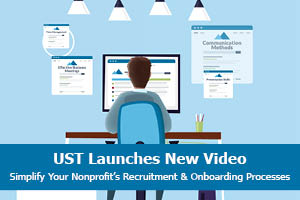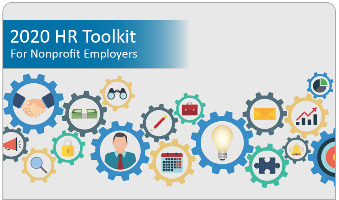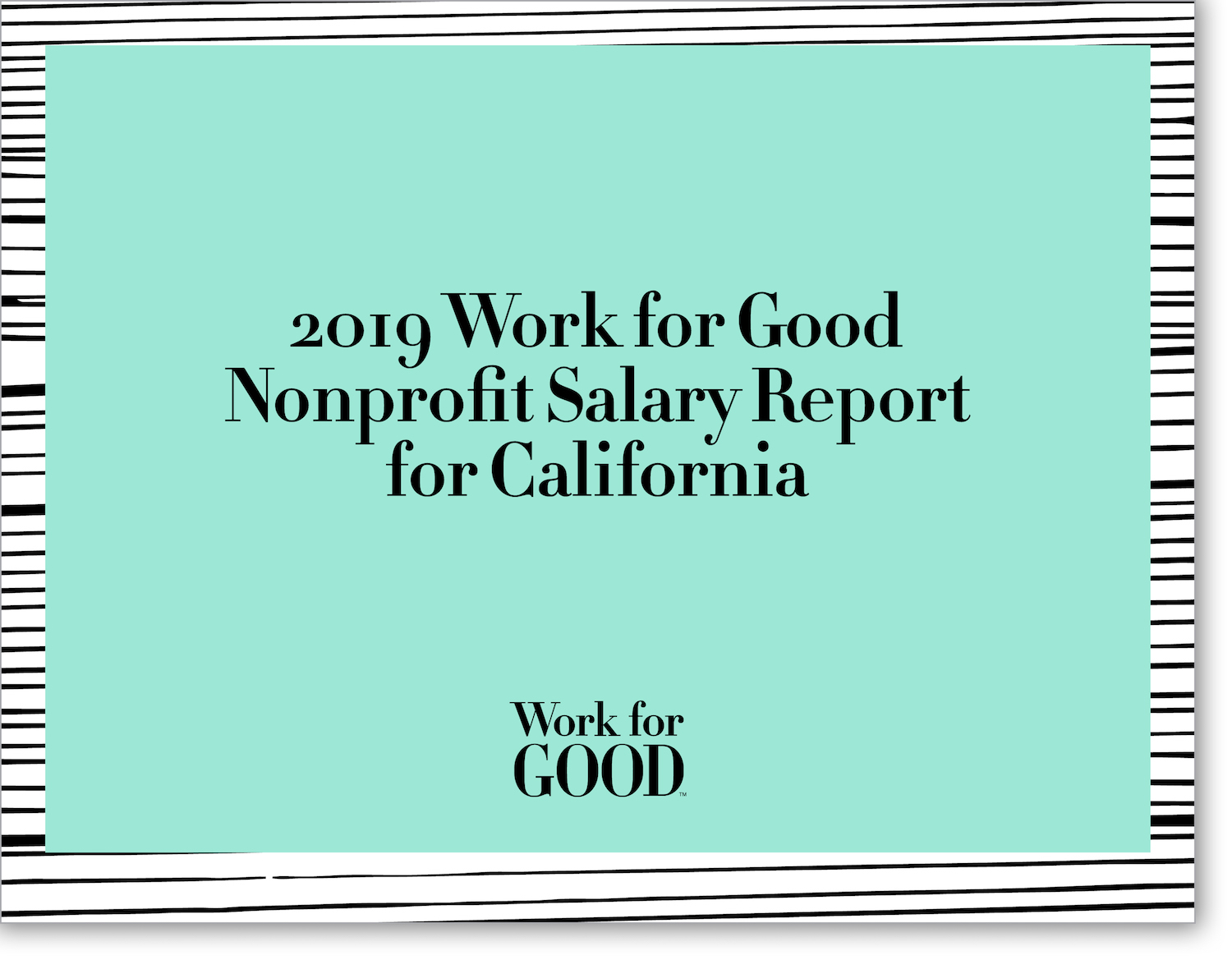
For over three decades, UST has been providing nonprofits with HR solutions that help manage day-to-day workforce issues, ensure compliance, and maximize employee bandwidth. By offering essential tools such as the job description builder, customizable online employee training tracks, and onboarding checklist, UST helps nonprofits maximize productivity and increase employee engagement.
As part of UST’s ongoing efforts to strengthen and educate 501(c)(3) organizations, we’re excited to announce the recent launch of our newest short video—designed to provide a snapshot of UST’s cloud-based HR platform. About a minute long, this video highlights tools that allow nonprofit employers to navigate the many complex realms of human resource management with ease—including recruitment and employee training.
Check out our newest video today to discover how our virtual HR services can help streamline your nonprofit’s HR processes and simplify day-to-day tasks—so you can focus more time on what matters most: keeping your mission-driven initiatives moving forward.
Test drive UST’s online HR platform today and explore some of these essential HR checklists and training solutions for yourself! Sign up for your FREE 60-Day HR Trial here!

Here at UST we’ve put together our Top 10 Guides for 2020 Nonprofit Human Resource management. And for a limited time, we’re giving them away for FREE.
Since 1983, UST has provided nonprofits with the latest HR resources in an effort to help organizations stay compliant, maximize employee bandwidth and reduce overhead costs. This toolkit includes updated 2020 state and local minimum wage data and recordkeeping requirements, as well as a variety of checklists to ensure compliance. Plus, you can discover facts surrounding COVID-19 laws and the latest workplace protocol.
Still have questions? You can get a free 60-day trial of UST HR Workplace, powered by ThinkHR. This cloud-based HR platform offers a live expert hotline, 300+ online training and compliance courses, compensation tools, employee handbook builders and employee classification step-by-step guides. Set up your ThinkHR Trial today!

Nobody likes filing taxes or paying them for that matter but don’t let that put your nonprofit at risk. While your organization may be federally tax-exempt, you are still required to file Form 990 with the IRS. This is the only way the federal government can ensure exempt organizations are conducting business in a way that is consistent with their public responsibilities. It also ensures your compliance and evaluates how your nonprofit is doing financially while allowing the public to see information about a nonprofit mission and programs.
The 990 provides a transparent glance into the organization and its accomplishments. Allowing the public to see, not only, the gross revenue generated but where the revenue came from. When individuals, donors or job seekers are trying to find out as much as possible about a nonprofit through their own research efforts, this is an excellent source of information since it serves as a tool to evaluate the best charities to support.
It’s important that you file and file on time. Your 990 is due by the 15th of the 5th month after your accounting period ends. For example, if your fiscal year ends on December 31st, your 990 would be due by May 15th of the following year. Which form you file depends on your gross receipts—you can determine which 990 form to file by visiting the IRS website to see which form category your nonprofit falls under. Take the time to complete this form and avoid losing your exempt status with the IRS—there is no appeal process. If you’re unsure of your status, check the IRS website and get back on track, you will thank yourself later.
Understanding the journey, planning ahead and being proactive, will save you time and make the filing process much easier. Following the below guidelines can help with that preparation:
Since 990 forms are public documents and widely available, nonprofits should be diligent about filing them out correctly and filing them on time. Remember, a nonprofit’s 990 provides valuable information that speaks directly to your organizations status so the extra time spent preparing will pay off in the end. Don’t think of it as another menial task on your list of things to do but rather consider how it can affect those researching who you are—ultimately impacting the communities you serve.

Employing the third largest workforce with the third largest employee payroll, the nonprofit sector is quickly gaining momentum in the work arena. Work for Good recently released a new eBook, the 2019 Nonprofit Salary Report for California, based on results from an extensive survey of nonprofit professionals in the state. This eBook delivers comprehensive sector salary benchmarking based on nearly 10,000 positions at nonprofit organizations in the state of California. Those are impressive statistics and this report breaks down those numbers for you—helping in your quest for greater impact and organizational excellence. Download your copy today!
Different things inspire different people to work for nonprofit organizations—it can be a personal tie to the cause, the desire to make a difference, the work environment, or maybe, it’s the idea of working with really like-minded people. Whatever the reason is, it typically isn’t for stellar compensation.
While some nonprofits have the funds to offer exceptional compensation, many just don’t—there are a lot of reasons why nonprofit organizations struggle with offering competitive compensation packages but the most common are minimal funding and other spending priorities. We know there are many non-monetary rewards of working for a nonprofit, but creating the best compensation package possible can make the difference between attracting and retaining qualified candidates or suffering from high turnover. It’s important to recognize that nonprofit employers compete with for-profit employers all the time when it comes to finding talented job candidates. Equally important to recognize is that compensation isn’t just about salary.
Like all other employers, tax-exempt charitable nonprofits are required to follow federal and state wage and hour laws that include minimum wage requirements. To maintain their tax-exempt status, nonprofit organizations need to ensure that compensation is reasonable and not in excess. Performing your own data research to find out what the “going rate” is for a given position can be extremely helpful in ensuring that you’re aligned with other nonprofits in the same geographic area with a similar budget and mission.
Here are some things to consider when creating a desirable compensation package:
1 . Incentive Bonuses – Ensure expectations are clear surrounding any bonus through corporate communications that explain how bonuses are recognized as a discretionary gift to a regular salary–dependent upon budget limitations, and provided in recognition of an employee’s extra-efforts or exceptional performance.
2. Work from Home Opportunities – Provide employees the option to telecommute in an effort to save time and money on commuting back and forth from work. Make sure that you have a clear policy surrounding a telecommuting program to avoid any possible issues in the future.
3. Recognition Awards – Recognize employee’s successes on a quarterly basis by rewarding them with an additional perk such as a gift card to a local hot spot or perhaps a paid day off. This type of recognition carries extra meaning in building trust and loyalty.
4. Additional Time off – Offering additional time off options such as a floating holiday or a paid birthday can go a long way in making employees feel valued and cared for.
5. Perks and Memberships – More and more companies are providing their associates free memberships to discounted programs and offering special offers.
6. Increase Training Spending – Consider paying for certification programs, learning materials and conferences. Create more budget space for investing in employees.
Being creative with your compensation package at a budget restricted nonprofit can be less expensive and often better received than a raise, so put on your thinking caps and leave no stone unturned. R emember, money alone will not keep employees engaged so make sure you show them some appreciation.
Nonprofits play a vital role in society by indirectly boosting the economy. Just like their for-profit counterparts, they have payroll, pay mortgages and utilities and have overhead costs. Unlike for-profits, they rely primarily on grants, donors and the community for financial support – making it all the more important that they understand the financial risks they face.
Earlier this year, the findings from a study put out by SeaChange Capital Partners, Oliver Wyman and GuideStar, “The Financial Health of the United States Nonprofit Sector: Facts and Observations,” were released and the results signaled an urgency for improved risk management to reduce the likelihood of financial distress within the sector.
Some key takeaways from this report include:
If you missed it, download your copy today and learn how you can either put a holistic risk management framework in place or enhance your current risk management practices!
UST offers their highest attended webinar- learn more about the unique tax alternative provided to 501(c)(3) nonprofits.
UST, a program dedicated to providing nonprofits with dedicated HR support and educational tools, presents a short on-demand webinar to showcase some of the most common unemployment & HR risks that are costing nonprofits thousands of dollars annually.
UST shares insights into their many service offerings as well as best practices that can help reduce costs and streamline workforce processes.
This educational webinar also teaches nonprofits about:
“Whether your primary focus to protect your assets, ensure compliance, reduce unemployment costs or to simply allocate more time and money to your mission-driven initiatives, this webinar can provide invaluable insight that can help you to refocus your funding and employee bandwidth on the communities you serve,” said Donna Groh, Executive Director of UST.
This webinar will also explore UST’s holistic program, which is already helping more than 2,200 participating nonprofits lower their unemployment and HR liability. If you work for a 501(c)(3) nonprofit with 10 or more full time employees, be sure to watch this webinar today!
Question: Can we maintain a zero-tolerance marijuana use policy in our workplace if medical marijuana use is legal in the state?
Answer: Yes, you can. Employers have an absolute right to maintain a drug-free workplace and do not have to allow or tolerate drug use or intoxication in the workplace. Although some states permit the use of marijuana for both medicinal and recreational purposes, most state laws provide exemptions for employers to prohibit the use of marijuana in the workplace. If you maintain a drug-free workplace, then your employees may be subject to discipline and/or termination when working under the influence of marijuana (i.e., on-the-job intoxication). In states where marijuana use has been legalized for medical or recreational purposes, employers may elect to establish intoxication standards for marijuana metabolites, rather than imposing discipline for any presence of the drug. However, this standard must be applied consistently and regularly to all employees.
As of February 2016, marijuana continues to be an illegal drug under federal law (which trumps state laws), and employers are not required to permit on-the-job use of or marijuana intoxication by employees or applicants. You may discipline employees who are legally using marijuana under state law but who are in violation of your workplace policy, because under the law, employees are not protected from being fired for failing a drug test.
Alternatively, you may elect to accommodate your employee’s medical marijuana use, but the Americans with Disabilities Act (ADA) does not require you to reasonably accommodate current unlawful drug use. Employees who claim disability discrimination for their medical marijuana use may attempt to file under the ADA. However, the ADA excludes current illegal drug users from protection; therefore, employers are free to conduct drug tests on employees, subject to certain limitations, to detect the presence of illegal drug use.
Refer to your state’s laws on employer rights and medical marijuana law. Additionally, you may want to update your policies to ensure you are clear about whether you will accommodate marijuana use in the workplace and the subsequent action should an employee be found using marijuana.
Finally, keep in mind that this issue can be complicated. When in doubt, seek legal counsel to ensure compliance.
Q&A provided by ThinkHR, powering the UST HR Workplace for nonprofit HR teams. Have HR questions? Sign your nonprofit up for a free 30-day trial here.

Overqualified candidates can often be challenging for nonprofits to take on—while experience, knowledge and self-sufficiency can be appealing, the potential for boredom and chances for increased turnover in the workplace can make any employer feel uneasy. While there are both benefits and downsides to hiring overqualified candidates, finding a middle ground is key to gaining the most value from these particular hires and providing work that continues to challenge them.
The “right” overqualified candidate can bring a plethora of skill sets to a nonprofit organization—experience, expertise, proficiency in basic skills, leadership potential and the ability to take on challenging projects and tasks. Unfortunately, the chance of these candidates being ruled out solely on a brief look at their resume happens more often than we think.
Often, a presumed risk among nonprofit organizations is that these candidates may become bored, unmotivated or leave the position quickly. On the bright side, overqualified candidates are likely to be able to hit the ground running. Already being equipped with the basic skills needed for the position, they likely don’t require too much hand-holding. In the long-run, this can help you save valuable time and money when it comes to onboarding.
The key to bringing on any new hire is finding the right balance. When it comes to an overqualified candidate, an employer may have concerns about training because they may have habits that are difficult to modify. On the other hand, if the candidate is educated about the culture and values of your organization during the recruitment process, they will embrace and absorb new formalities relatively quickly.
To avoid being a “life raft” or “stepping stone”, it is important to be honest and transparent with a candidate that is overqualified. Explain your concerns about the role in comparison to their experience and be upfront about your expectations. One of the most common concerns is the topic of salary. During these conversations, it’s important to touch on the candidate’s long-term career goals, including what motivated them to apply for this position and what they hope to contribute to the organization.
Last but not least, remember to keep an open mind! While a candidate may look like they are overqualified on paper, they may have a personal reason for applying to the position. They may be looking to switch into a different industry that they’re more passionate about… they may have always wanted to work for a nonprofit and it’s beneficial for you to find out whether they could be a positive addition to your team and help further strengthen your mission.
It’s no secret that people are more health conscious today than ever before. And over the last few years, business owners have gotten on board with a massive influx of corporate wellness programs being offered in the workplace. We’re talking everything from stability balls and standing desks to weight loss programs and opportunities to work from home.
It seems now, that employers are constantly looking for new ways to kick their corporate wellness programs up a notch. And the trends are getting more and more creative with companies expanding the definition of wellness through offerings that are much broader – improving the overall quality of their employees’ lives.
Some things are as easy as implementing standing desks as the standard – the kind you can move up or down so employees aren’t forced to do one activity or the other all day. While the debate continues over the health benefits, no one can argue that having the option to change your form throughout the day helps with muscle stiffness, brain fog and calorie expenditure.
Opportunities to work from home have rapidly become a hot trend but some organizations are still reluctant to let go of that much visibility. For many, it works like a well-oiled machine but for others, it ends up being one issue after another. You really have to take the time to evaluate your staff to see whether or not, they can handle that much responsibility – it’s definitely not for everyone but certainly worth doing the research.
At the top of the corporate wellness trends right now is “wellness technology”. Some companies are looking for ways to put all of that valuable information gathered by all those fitness gadgets to work. By working to keep corporate wellness offerings fresh, some employers are using Chatbots to help keep employees on track with their fitness goals.
Then there are those forward thinking companies who are looking to bring on the latest and greatest wellness programs for their employees. For example, one organization has an in-house masseuse available to their employees while another has a built-in office sauna. Others are subsidizing DNA kits, creating nap rooms, implementing vending machines with healthy snack options or offering an on-site Happy Hour at the end of the day.
It goes without saying that the possibilities are endless. Since workplace stress has become the biggest epidemic to hit corporate America in recent years—it is worth addressing internally through some form of wellness program that will help employees regain focus and energy. When employees don’t know how to manage their stress, not only is their work affected but so are the people around them. And the benefits of making your employees’ well-being a priority are endless – it can help with retention, reduce absenteeism and workers’ compensation claims, increase productivity as well as save your organization thousands in the long run.

UST maintains a secure site. This means that information we obtain from you in the process of enrolling is protected and cannot be viewed by others. Information about your agency is provided to our various service providers once you enroll in UST for the purpose of providing you with the best possible service. Your information will never be sold or rented to other entities that are not affiliated with UST. Agencies that are actively enrolled in UST are listed for review by other agencies, UST’s sponsors and potential participants, but no information specific to your agency can be reviewed by anyone not affiliated with UST and not otherwise engaged in providing services to you except as required by law or valid legal process.
Your use of this site and the provision of basic information constitute your consent for UST to use the information supplied.
UST may collect generic information about overall website traffic, and use other analytical information and tools to help us improve our website and provide the best possible information and service. As you browse UST’s website, cookies may also be placed on your computer so that we can better understand what information our visitors are most interested in, and to help direct you to other relevant information. These cookies do not collect personal information such as your name, email, postal address or phone number. To opt out of some of these cookies, click here. If you are a Twitter user, and prefer not to have Twitter ad content tailored to you, learn more here.
Further, our website may contain links to other sites. Anytime you connect to another website, their respective privacy policy will apply and UST is not responsible for the privacy practices of others.
This Privacy Policy and the Terms of Use for our site is subject to change.
UST maintains a secure site. This means that information we obtain from you in the process of enrolling is protected and cannot be viewed by others. Information about your agency is provided to our various service providers once you enroll in UST for the purpose of providing you with the best possible service. Your information will never be sold or rented to other entities that are not affiliated with UST. Agencies that are actively enrolled in UST are listed for review by other agencies, UST’s sponsors and potential participants, but no information specific to your agency can be reviewed by anyone not affiliated with UST and not otherwise engaged in providing services to you except as required by law or valid legal process.
Your use of this site and the provision of basic information constitute your consent for UST to use the information supplied.
UST may collect generic information about overall website traffic, and use other analytical information and tools to help us improve our website and provide the best possible information and service. As you browse UST’s website, cookies may also be placed on your computer so that we can better understand what information our visitors are most interested in, and to help direct you to other relevant information. These cookies do not collect personal information such as your name, email, postal address or phone number. To opt out of some of these cookies, click here. If you are a Twitter user, and prefer not to have Twitter ad content tailored to you, learn more here.
Further, our website may contain links to other sites. Anytime you connect to another website, their respective privacy policy will apply and UST is not responsible for the privacy practices of others.
This Privacy Policy and the Terms of Use for our site is subject to change.